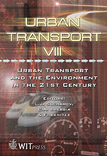The Structural Dependency On Car Use For The Swedish Urban Population
Price
Free (open access)
Transaction
Volume
60
Pages
12
Published
2002
Size
667 kb
Paper DOI
10.2495/UT020031
Copyright
WIT Press
Author(s)
M. Reneland
Abstract
Using GIS techniques, this project, financed by KFB The Swedish Transport and Communications Research Board, deals with the 45 Swedish towns with more than 20000 inhabitants (those in the Stockholm region are excluded), and shows characteristic information about population, employees within different categories (retail shops, amusements, and care), car ownership etc. within a pedestrian zone (1 km from the centre point of each town), and a bicycle zone of 3 km. The findings show that most of the Swedish towns have a similar structure. High population density, many employees, many retail shops, small proportion green areas and low ear ownership characterize the central parts. With increased distance from the town centre the population density, number of employees and number of retail shops decrease while the proportion of green area and the car ownership increases. However I consider that a great deal of the Swedish urban population have a convenient (maximum 15 minutes) distance by bicycle from their home to a large proportion of the town services and workplaces. In 1995, 65% of the population in the towns studied, i.e. 1705000 inhabitants, lived within a distance of 3 km from the town centre. Furthermore, a large proportion lived within convenient walking distance (maximum 15 minutes). In 1995, 18% the population in the towns studied, i.e. 468000 inhabitants, lived within a distance of 1 km from the town centre. Since the proportion of short car trips is very high in urban areas, (70-80% are shorter than 4 km), there is a great potential for reduction of car use in towns. This reduction could probably take place without any serious losses in the economy of individuals, companies and society, which gives considerable freedom of choice for the Swedish government and local authorities when it comes to the design of a traffic policy for a sustainable society.
Keywords





